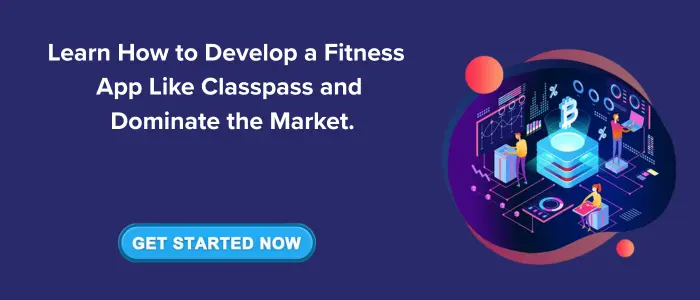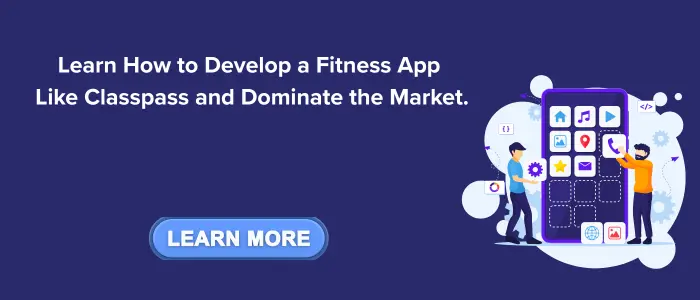In the era of fitness on demand and flexible workout routines, apps like Classpass have revolutionized the way people engage with gyms, studios, and trainers. If you’re an entrepreneur or business owner considering venturing into the fitness app market, this detailed guide will help you understand how to develop an app like Fitness Classpass, including its features, tech stack, legal requirements, monetization strategies, and development costs.
Why Build an App like Fitness Classpass?

Classpass has disrupted the fitness industry by offering users access to multiple fitness studios, gyms, and wellness services through a single app with flexible subscriptions. Developing a similar app offers several benefits:
- Massive Market Potential: The global fitness app market is expected to reach over $20 billion by 2030.
- Recurring Revenue Model: Subscription-based apps generate steady income.
- Growing Health Consciousness: Post-pandemic, users demand hybrid fitness solutions (online + offline).
- Partnership Opportunities: Collaborate with fitness centers, wellness spas, personal trainers, and nutritionists.
Also Read: Cost to Build a Fitness App Like Strava.
Key Features of an App Like Classpass

1. User Registration & Profiles
Easy sign-up via email, phone number, or social media (Google, Facebook, Apple ID).
Personalized user profiles with preferences, fitness goals, and workout history.
Profile photo, emergency contact info, and medical condition notes (optional).
Option to set fitness milestones and receive achievement badges.
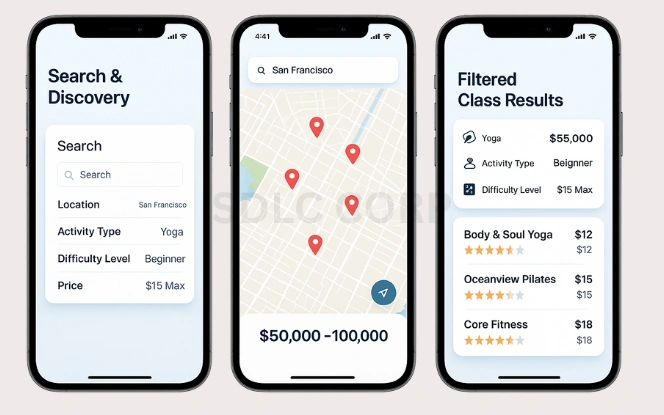
2. Search & Discovery
Filter by location, activity type (yoga, HIIT, pilates), difficulty level, duration, and price.
Interactive map integration to find nearby studios, gyms, or classes.
Sort results by rating, popularity, or availability.
Smart recommendations based on previous bookings and preferences.

3. Subscription Plans & Wallet
Multiple plan options (pay-per-class, monthly, quarterly, yearly).
In-app wallet and credit system to manage class credits easily.
Auto-renewal management with pause or cancel options.
Promo codes, discounts, and referral bonus integration.

4. Integration with Wearables
Sync with popular fitness trackers (Fitbit, Apple Watch, Google Fit).
Real-time tracking of steps, calories burned, and heart rate during classes.
Display workout summaries within the app.
Notifications/reminders for fitness goals based on wearable data.

5. Ratings & Reviews
Feedback on classes, studios, trainers, and overall experience.
Option to add photos or videos in reviews.
Reply feature for studios/trainers to respond to reviews.
Star ratings combined with written feedback for more transparency.

6. Admin Panel
Manage partners (gyms, studios), bookings, trainers, and payment settlements.
Analytics dashboard showing class attendance, revenue, churn rate, and growth stats.
Push notification management for promotions and updates.
Automated invoicing and financial reporting tools.
Explore: How Much Does It Cost to Develop a Fitness Tracking App Like Noom?
Technology Stack for Fitness App Development
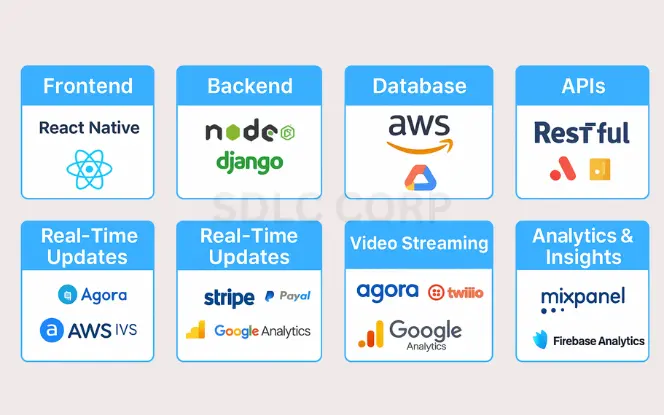
Here’s a recommended tech stack to build a robust app like Classpass:
Frontend (Mobile App): React Native or Flutter (cross-platform development for iOS and Android)
Backend (Server-side): Node.js (JavaScript) or Django (Python)
Database: PostgreSQL (SQL, relational) or MongoDB (NoSQL, document-based)
Cloud Hosting: AWS (Amazon Web Services), Google Cloud, or Microsoft Azure
Payment Gateway: Stripe, PayPal, or Razorpay (secure and global payment solutions)
Real-Time Updates: Firebase (Realtime Database, Notifications) or WebSocket
Maps & Geolocation: Google Maps API (location-based services and navigation)
Video Streaming: Agora, Twilio, or AWS IVS (for live and on-demand video classes)
Analytics & Insights: Mixpanel, Google Analytics, or Firebase Analytics (user behavior tracking)
Legal Requirements to Consider

When developing a fitness booking app, legal compliance is crucial:
User Data Privacy: Comply with GDPR, CCPA, or other local privacy laws.
Liability Waivers: Users must agree to terms that limit liability for injuries during workouts.
Partnership Contracts: Clear agreements with fitness studios and trainers.
Payment Security: PCI-DSS compliance for handling payments.
Monetization Strategies

To make your app like Classpass profitable, here are effective monetization models:
- Subscription Plans: Monthly/yearly plans with varying credits.
- Pay-as-you-go: Users pay for individual sessions.
- Freemium Model: Basic access is free; premium features (e.g., virtual sessions) require payment.
- Partnership Revenue: Charge studios a commission per booking.
- Advertisements & Sponsored Listings: Highlight certain partners or promote fitness products.
- Affiliate Marketing: Partner with wellness brands for commissions on product sales.
Learn More: Cost to develop AI Fitness apps like Freelestis, Fitbod, Cult, Fitness AI, Asensei: A Comprehensive Guide.
Development Cost Breakdown
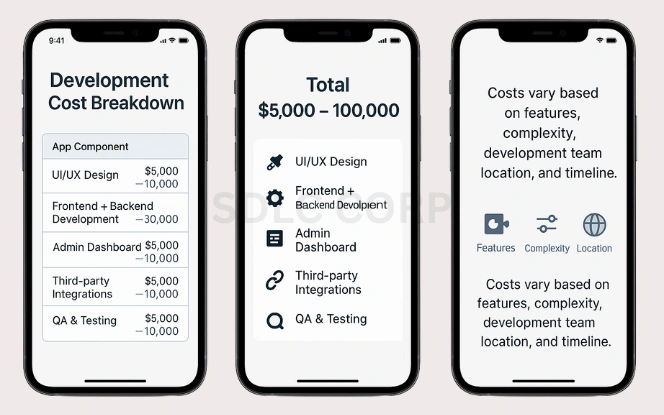
A common question is: How much does it cost to develop an app like Fitness Classpass?
| App Component | Estimated Cost |
|---|---|
| UI/UX Design | $5,000 - $10,000 |
| Frontend + Backend Development | $30,000 - $60,000 |
| Admin Dashboard | $5,000 - $10,000 |
| Third-party Integrations (Maps, Payments, Video) | $5,000 - $10,000 |
| QA & Testing | $5,000 - $10,000 |
| Total (MVP) | $50,000 - $100,000 |
Steps to Develop an App Like Classpass

Here’s a step-by-step process for building your app:
1 Market Research
Study competitors like Classpass, Mindbody, and Gympass.
Identify gaps and unique selling points (USP).
2 Define Requirements
Decide core features vs. add-ons.
Create user journey maps.
3 UI/UX Design
Build wireframes and prototypes.
Focus on ease of booking and a clean interface.
4 App Development
Choose an agile methodology for iterative releases.
Develop backend APIs, frontend screens, and admin tools.
5 Integrate APIs
Payment gateway, maps, video streaming, and analytics.
6 Testing
Conduct unit testing, integration testing, and user acceptance testing.
7 Launch & Marketing
Soft launch for beta feedback.
Promote through social media, influencers, and app stores.
8 Post-launch Support
Regular updates, bug fixes, and adding features based on feedback.
Explore: Why WordPress Helps Build Health and Fitness Websites?
Challenges in Building a Fitness Booking App

Be aware of potential hurdles:
- Managing partnerships with diverse studios.
- Ensuring accurate real-time booking availability.
- Retaining users in a competitive market.
- Balancing commission rates so both users and partners are satisfied.
- Handling video streaming quality for virtual classes.
Best Practices for Success

- Personalization: Offer AI-powered class suggestions.
- Gamification: Reward users for regular bookings.
- Community Building: Integrate social sharing, leaderboards, or group challenges.
- Data Analytics: Track user behavior to refine offerings.
Conclusion
Building an app like Fitness Classpass combines smart technology with a deep understanding of fitness enthusiasts’ needs. By focusing on user experience, robust tech architecture, and strategic partnerships, you can launch a successful app that stands out in the competitive fitness space.
At SDLC Corp, we specialize in building apps tailored to your business goals. From concept to launch, our experienced team will guide you through the entire development process, ensuring scalability, security, and a user-friendly experience.
FAQ's
How Much Does It Cost to Develop an App Like Fitness Classpass?
The cost typically ranges between $50,000 to $100,000 for an MVP (Minimum Viable Product). This varies based on app complexity, features, third-party integrations, and development team location.
How Long Does It Take to Build a Classpass-like Fitness App?
Development time is usually between 4 to 8 months, depending on the feature set, design complexity, and testing cycles.
Which Technologies Are Best for Developing a Fitness App?
A robust stack includes React Native or Flutter (frontend), Node.js or Django (backend), and AWS or Google Cloud for hosting. Integration with APIs like Google Maps, Stripe, and Twilio is common.
How Can I Monetize a Fitness App Like Classpass?
You can earn through subscriptions, pay-per-class bookings, ads, affiliate marketing, and partner commissions from fitness studios and trainers.
Is It Necessary to Integrate Wearables in a Fitness App?
While not mandatory, integrating with wearables (Fitbit, Apple Watch, Google Fit) can greatly enhance user engagement by offering activity tracking and personalized insights.

